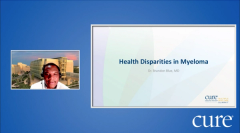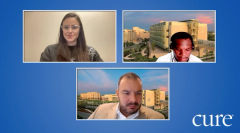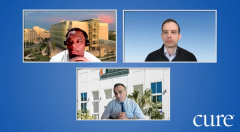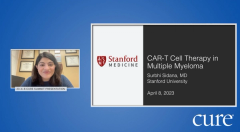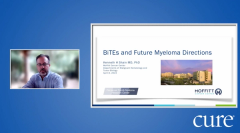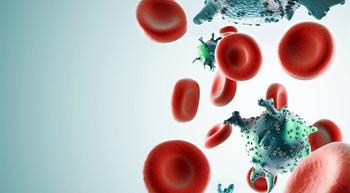
Educated Patient® Multiple Myeloma Summit Myeloma Management Panel: April 8, 2023
Watch Dr. Brandon J Blue, Dr. Dickran Kazandjian and Dr. Marc J. Braunstein answer questions about disease management during the CURE Educated Patient Multiple Myeloma Summit.
Episodes in this series

The Myeloma Management Panel was moderated by summit chair Dr. Brandon J Blue, a clinical instructor in the Department of Malignant Hematology at Moffitt Cancer Center, and included Dr. Dickran Kazandjian, professor of medicine in the Division of Hematology at University of Miami Health System, and Dr. Marc J. Braunstein, from NYU Langone Health.
Blue: Thanks so much. And I just want to say thanks to our presenters, you guys did a fantastic job. And for those who are new to this section, I'm Dr. Brandon Blue coming from Moffitt Cancer Center in Tampa, Florida.
So now that we learned a little bit about the treatment different modalities of multiple myeloma, there's a couple questions that hopefully you lovely gentleman can answer this afternoon.
One of the questions was, I'll start off with (Dr. Kazandjian), one of the things that you had mentioned was, a lot of your patients down in Miami get (Darzalex [daratumumab]), Revlimid (lenalidomide) and dexamethasone as part of the MAIA study that you talked about. Can you talk about how you treat patients, once their disease is under control? Do you switch them to a maintenance (therapy)? Do you continue them on the same doses and medicines from the whole time? Or can you just talk a little bit about how things happen when you have those types of patients?
Kazandjian: Yeah, thank you, Brandon. I think that's an excellent question. And I have to tell you, I'm going to tell you what I do. It's not necessarily what the trial did or with evidence based. But what works in my clinic and I think what most people are probably doing, the reality is, I think when the MAIA study first started, the folks who designed the trial probably didn't realize that patients who could potentially be on it for such a long time, where, you know, some of these considerations have to take place.
So to answer your question directly, as long as the patient is tolerating everything, I continue the daratumumab and the Revlimid at the full dose, and the dexamethasone. The dexamethasone usually gets dose reduced at the initial half of a year probably at some point. But I usually continue that to about 12 months, or at 12 months I do sort of what I call restaging with bone marrow biopsy and PET CT. I think at that point, if patients are in (minimal residual disease [MRD])-negative remissions and things are going well, I have a conversation. And at that point, many times, I will actually dose reduce the Revlimid to about 10 milligrams. Kind of like more traditional maintenance therapies, especially if they're having side effects. And then my second milestone is the 18-month time point, at which time, again, if patients are in remission and doing well, otherwise, I will actually have a discussion with the patient and maybe either stop the daratumumab or the Revlimid.
I think it's very patient specific. You know, it's kind of like, would you rather go home on a pill and not have to see me as often or come into the clinic as often for maintenance strategy? Or would you rather not take a daily pill that probably has more side effects in the long term?
So I mean, that's what I've been doing. If patients are not in remission or MRD-negative remission, I tend to continue if they're tolerating it well. I tend to continue it the way the trial was written, which is really indefinitely. Pretty please note, just one more important thing is, there are a lot of those reductions in Revlimid, almost like many of the other trials when you lead the full dose, like 25 milligrams and Revlimid for more than a year, year and a half. On average, half of them probably need to be dose reduced.
Blue: Yeah, I would imagine a lot of us are doing something very similar to that. I appreciate you answering that question.
Dr. Braunstein, so up in New York, what are the upper age limits for transplant? You talked a little bit about fitness and some of those kinds of things in your talk. But one of the questions from the audience is, can you talk about age and who's too old? Or can you give a little bit more insight on fitness and age?
Braunstein: Sure. Thank you. Nice to see you both. It's a great question. And as I kind of alluded to in the talk, there really isn't an upper limit of age. Medicare loosely says 78 is the upper age limit for reimbursement. But I've had colleagues who provide autologous transplant for older patients as well. I think we have to look at overall fitness because there are young patients who may not be fit for transplant because of their comorbidities.
So it's not just about age but about other medical conditions. In general, (we use) fitness – and we actually have some myeloma-specific fitness metrics that we can use to see if a patient is perhaps too frail – and also patient preference and, to some extent, their status of their disease. So if I have someone who's, you know, perhaps older than 75 or so, who is standard risk, has responded very well to induction, just given their expected life expectancy, there may not be a need for autologous transplant in that setting. On the other hand, if they're higher risk, or if they are fit enough, and we make a shared decision that perhaps we can further consolidate their disease with autologous transplant, then I might move forward. So there really isn't an upper age limit, as much as a comprehensive assessment of their fitness.
Blue: Thank you. So I'm going to ask you this, Dr. Braunstein. No one is going to hold you to this, but if you had to foresee a predicted winner in this trial that you talked about, where CAR-T cell therapy is going to go head-to-head with transplant, do you have a favorite victor? Do you think, “Hey, I think this side is going to win over the other?” What are your thoughts?
Braunstein: A great question, and I appreciate you putting me on the spot without holding me to it. So I think we're seeing impressive results from CAR-T cells. Honestly, in the KarMMa-3 study I kind of just briefly highlighted, it seems like CAR-T cells provide longer time to progression than in our standard, conventional three-drug regimen in that study, whether that holds true in the upfront setting is a different story. Because we know that the longest remissions tend to happen upfront, and it's a little more difficult to show progression-free survival benefit in that setting.
I would say that I've been impressed by CAR-T cells. And I would think that that might provide more long-term duration of initial remission, perhaps due to immune-surveillance by the CAR-T cells that are longer lived, and providing some more long-term activity. You know, we don't have that much data. Interestingly, enough of maintenance after CAR-T cell therapy, and in this upfront study, everyone's getting Revlimid maintenance. So we'll see how that adds to or maybe detracts from the benefit of CAR-T cells up front. But if I had to hedge my bets, I'd say we may see a little bit longer progression-free survival with CAR-T cells. But I may be wrong, too.
Blue: All right. Well, you heard it here first, don't hold them to it. One of the questions from the audience was, how important is this MRD testing? And what should patients do if their treatment center doesn't offer it? If it's not something that their doctor has checked? Or it's not available? What should they do?
Kazandjian: Yeah, I think that that's a great question. I mean, I'm going to go out on a limb, but not really, I'm sure both you guys on the call are testing appropriately? In fact, just even before I answer your question, I think we have to be really careful, and patients have to be really careful, because those doctors that are not (treating) myeloma all the time, may not understand the kind of testing that's truly MRD negativity, by definition, by IMWG guidelines or consensus. What I'm talking about, I don't want to give the name of companies, but there are laboratory companies that are stating that these are MRD tests. And so the doctors may be thinking that they're ordering MRD tests. But when you look at the details, I mean, really like anything else, that the importance is in the details. The level of sensitivity is not at least 10 to the minus five, which is what we need.
So be careful. Have a look out on that. I'm going to be very strict here. I don't think there's any reason for any oncologist not to order MRD testing. The FDA clear test, it's Medicare covered, it can be central core, it's just about getting an administrative contract with the company at most maybe. And so, it should be available to everyone and anyone and, in fact, if it's not being available to patients, I think, you know, that's what makes the difference in going to one of our institutions that are really myeloma focused. I understand not everyone can get into a Myeloma Center of Excellence. But you know, you have to push and you know, we don't do bone marrows every month. So I have plenty of patients who are seen in the community, they may live three, four hours away, some fly from many hours away, and come in annually just to get that bone marrow biopsy done in our center, which does, both 10s of minus five in flow cytometry and sends out for next generation sequencing through that.
Blue: Perfect thank you so much. So you heard it here first, if they're not doing it, there's plenty of centers out there who can get that testing available for you. Dr. Braunstein, one of the questions says, can you explain why a lot of the trials and things that you've mentioned, showed that there was a benefit for transplant for progression-free survival, but not overall survival? Can you talk to that? Or what are your thoughts?
Braunstein: Sure. Thank you for the question. You know, I think that leads to a lot of academic debate about what the role of transplant is in the modern setting of anti-myeloma therapies that we use. Now. Some of the explanations for that might include the fact that there was crossover. In other words, patients who did not get their initial transplant, did eventually go for their transplant later on after they relapsed, that may blur the differences in survival. We have better therapies for relapsed disease now, and multiple options. So that can also, you know, prolong survival and make it harder to see differences between the two groups. So, those, I think, are some reasons why it's hard to show the differences.
But, you know, progression-free survival is a surrogate marker for overall survival. And, you know, as the therapies are improving, both upfront in the relapsed setting, the role of transplant may be more open to debate whether patients really need it upfront or not. But it's important to remember that not all patients were fit at that later time point when they delayed their transplant to later lines of therapy. So some would argue that your best bet is to still use it upfront (therapy) if you're going to proceed to transplant.
Blue: Yeah, and I hope the landscape of myeloma keeps evolving to the point where maybe we don't need some of the therapies we're doing in 2023 10 years from now. I think that's the whole goal is to make things better and better. So I think we have time for one last question. (Dr. Kazandjian), this one goes to you. It says, what is your understanding about the long-term use of this dexamethasone? It seems to be used in every therapy, even in patients who have been on therapy for many years, is it still considered an essential component in these combination therapies?
Kazandjian: Yeah, thank you. I mean, again, these are very, very good questions. As you know, Brandon, like dexamethasone has pennies, which basically means that unfortunately, no company or institution is going to ever really study a lot, you know, whether we need it or not. I mean, I think everyone knows on the call, there was the pivotal study that really showed that high-dose steroids for myeloma, it was actually negatively impacted compared to lower dose. But I think that the medicine also plays a number of things. So we give it as an anti-myeloma regimen, but as we know, that's very short lasting. But we also give it because it helps us indirectly prophylactically, especially some of these immunotherapies, to prevent reactions and fusion reactions, or maybe even some potential cytokine release syndrome.
I think it's still an important part of the regimens. But I think, at least in my clinic, it's more important upfront for the first few cycles. I read very rapidly that decreased dexamethasone, and many of my patients, especially if they're upper in age, to get something more like along the lines, like instead of 44 milligrams, you know, dexamethadone are equivalent, for example. That being said, I know some of the companies leading by specific antibody trials are actually really pushing to get away from dexamethadone, and they are actually de-escalating to zero, and actually even eliminating it from the regimen name. (With these drug regimen acronyms), the (lower case) d (always stands for) dexamethasone, and some of these companies are even getting rid of that small d to show that. They're really taking it out after maybe three, four cycles. And with even immunotherapies, it seems like you can do it. I do it all the time with daratumumab. I mean, I usually cut it out and I have not really had any problems. So on the other hand, absolutely, I think long-term steroids can cause detriment for patients. And so you can probably reduce it. It's probably a good thing to do. That is my gut feeling on that, Brandon.
Blue: Thank you so much, gentlemen. I appreciate you guys so much for really taking the time out. I thank all the listeners for listening to this section about management of myeloma.
For more news on cancer updates, research and education, don’t forget to

